The Language of SQL- P5 ppt
Bạn đang xem bản rút gọn của tài liệu. Xem và tải ngay bản đầy đủ của tài liệu tại đây (86.98 KB, 5 trang )
Another distinction of Access, compared to the other listed databases, is that it is
a desktop database. As such, it has great flexibility. Not only can you use it to
create a database that resides entirely in a single file on your PC, but it also allows
you to connect to more complex databases created with other tools, such as
Microsoft SQL Server.
Relational Databases
Let’s look at the basics of relational databases and how they work.
Basically, a relational database is a collection of data, stored in any number of
tables. The term relational is used to indicate that the tables are related to each
other. For example, let’s take the simple case of a database consisting of only two
tables: Customers and Orders. The Customers table contains one record for each
customer who has ever ordered. The Orders table has one record for each order
placed. Each table can contain any number of fields, which are used to store the
various attributes associated with each record. For example, a Customer table
might contain fields such as First Name and Last Name.
At this point, it’s useful to visualize some tables and the data they contain. The
common custom is to display a table as a grid of rows and columns. Each row
represents a record in the table. Each column represents a field in the table. The
top header row normally has the field names. The remaining rows show the
actual data.
In SQL terminology, records and fields are actually referred to as rows and
columns, corresponding to the visual representation. So henceforth, we’ll use the
terms rows and columns rather than records and fields to describe the design of
tables in relational databases.
Let’s look at an example of the simplest possible relational database. In this
database, there are only two tables, Customers and Orders. Thi s is what these
tables might look like:
Customers table:
CustomerID FirstName LastName
1 William Smith
2 Natalie Lopez
3 Brenda Harper
Chapter 1
■
Relational Databases and SQL6
Orders table:
OrderID CustomerID OrderAmount
1 1 50.00
2 1 60.00
3 2 33.50
4 3 20.00
In this example, the Customers table contains three columns: CustomerID,
FirstName, and LastName. There are currently three rows in the table, represent-
ing William Smith, Natalie Lopez, and Brenda Harper. Each row represents a
different customer, and each column represents a different piece of information
about the customer. Similarly, the Orders table has three columns and four rows.
This indicates that there are four orders in the database and three attributes for
those orders
Of course, this example is highly simplistic and only hints at the type of data that
could be stored in a real database. For example, a Customers table would normally
contain many additional columns describing other attributes of a customer, such
as city, state, ZIP, and phone. Similarly, an Orders table would ordinarily have
columns describing additional attributes of the order, such as order date, sales tax,
and the salesperson who took the order.
Primary and Foreign Keys
Note the first column in each table: CustomerID in the Customers table and
OrderID in the Orders table. These columns are commonly referred to as primary
keys. Primary keys are useful and necessary for two reasons. First, they enable you
to uniquely identify a single row in a table. For example, if you wanted to retrieve
the row for William Smith, you could simply use the CustomerID column to
obtain the data. Primary keys also ensure uniqueness. In designating the Custo-
merID column as a primary key, this guarantees that this column will have a
unique value for every row in the table. Even if you happened to have two dif-
ferent men both named William Smith in your database, those rows would have
different values in the CustomerID column.
In this example, the values in the primary key columns don’t have any particular
meaning. In the Customers table, the CustomerID column contains the values 1,
Primary and Foreign Keys 7
2, and 3 for the three rows in the table. It is often the case that database tables are
designed in such a way as to generate sequential numbers automatically for the
primary key column as new rows are added to the table. This design feature is
usually referred to as auto-increment.
A second reason for primary keys is that they allow you to relate one table to
another easily. In this example, the CustomerID column in the Orders table
points to a corresponding row in the Customers table. Looking at the fourth row
of the Orders table, you’ll notice that the CustomerID column has a value of 3.
This means that this order is for the customer with a CustomerID of 3, who
happens to be Brenda Harper. The use of commo n columns among tables is an
essential design element in relational databases.
In addition to merely pointing to the Customers table, the CustomerID column
in the Orders table can be designated as something called a foreign key. I’ll cover
foreign keys in detail in Chapter 18, but for now, just be aware that foreign keys
can be defined in order to ensure that the column has a valid value. For example,
you would not want the CustomerID column in the Orders table to have a value
unless that CustomerID actually existed in the Customers table. The designation
of a column as a foreign key can accomplish that restriction.
Datatypes
Primary and foreign keys add structure to a database table. They ensure that all
tables in a database are accessible and properly related to each other. Another
important attribute of every column in a table is a datatype.
Datatypes are simply a way of defining the type of data that the column can con-
tain. A datatype must be specified for each column in every table. Unfortunately,
there is a great deal of variation between relational databases as to which datatypes
are allowed and what they mean. For example, Microsoft SQL Server, MySQL, and
Oracle each have over 30 different allowable datatypes.
It would be impossible to cover the details and nuances of every available data-
type, even for just these three databases. What I will do, however, is to summarize
the situation by discussing the main categories of datatypes that are common to
most databases. Once you understand the important datatypes in these cate-
gories, you will have little trouble with other datatypes you may encounter.
Generally, there are three important kinds of datatypes: Numeric, Character, and
Date/Time.
Chapter 1
■
Relational Databases and SQL8
Numeric datatypes come in a variety of flavors, including bits, integers, decimals,
and real numbers. Bits are numeric datatypes, which allow for only two values,
0 and 1. Bit datatypes are often used to define an attribute as having a simple true
or false type of value. Integers are numbers without decimal places. Decimal
datatypes can contain decimal places. Unlike bits, integers, and decimals, real
numbers are those whose exact value is only approximately defined internally.
The one distinguishing characteristic of all numeric datatypes is that they can be
included in arithmetic calculations. Here are a few representative examples of
numeric datatypes from Microsoft SQL Server, MySQL, and Oracle.
General
Description
Microsoft SQL
Server Datatype
MySQL
Datatype
Oracle
Datatype Example
bit bit bit (none) 1
integer int int number 43
decimal decimal decimal number 58.63
real float float number 80.62345
Character datatypes are sometimes referred to as string or character string data-
types. Unlike numeric datatypes, character datatypes aren’t restricted to num-
bers. They can include any alphabetic or numeric digit and can even contain
special characters, such as asterisks. When providing a value for character data-
types in SQL statements, the value always needs to be surrounded by single
quotes. In contrast, numeric datatypes never utilize quotes. Here are a few
representative examples of character datatypes.
General
Description
Microsoft SQL
Server Datatype
MySQL
Datatype
Oracle
Datatype Example
variable length varchar varchar varchar2 'Thomas Edison'
fixed length char char char '60601'
The second example (60601) looks like it might be a numeric datatype since it’s
composed only of numbers. This is not an unusual situation. Even though they
contain only numbers, ZIP codes are usually defined as character datatypes
because there is never a need to perform arithmetic calculations with ZIP codes.
Date/time datatypes are used for the representation of dates and times. Like
character datatypes, date/time datatypes need to be enclosed in single quotes.
Datatypes 9
These datatypes allow for special calculations involving dates. For example, you
can use a special function to calculate the number of days between any two date/
time dates. Here are a few examples of date/time datatypes.
General
Description
Microsoft SQL
Server Datatype
MySQL
Datatype
Oracle
Datatype Example
date date date (none) '2009-07-15'
date and time datetime datetime date '2009-07-15 08:48:30'
NULL Values
Another important attribute of individual columns in a table is whether or not
that column is allowed to contain null values. A null value means that there is no
data for that particular data element. It literally contains no data. Null values are
not the same as spaces or blanks. Logically, null values and spaces are treated
differently. The nuances of retrieving data that contains null values will be
addressed in detail in Chapter 8.
Many SQL databases will display the word NULL in all capital letters when dis-
playing data with null values. This is done so the user can tell that it contains a null
value and not simply spaces. I will follow that convention and display the word as
NULL throughout the book to emphasize that it represents a unique type of value.
Primary keys on a database can never contain NULL values. That is because
primary keys, by definition, must contain unique values.
The Significance of SQL
Before we leave the subject of relational databases, I’d like to review a bit of
history in order to give you an appreciation of the usefulness of relational data-
bases and the significance of SQL.
Back in the Stone Age of computing (the 1960s), data was typically stored either
on magnetic tape or in files on disk drives. Computer programs, written in lan-
guages such as FORTRAN and COBOL, typically read through input files and
processed one record at a time, eventually moving data to output files. Processing
was necessarily complex since procedures needed to be broken down into many
individual steps involving temporary tables, sorting, and multiple passes through
data until the right output could be produced.
Chapter 1
■
Relational Databases and SQL10









